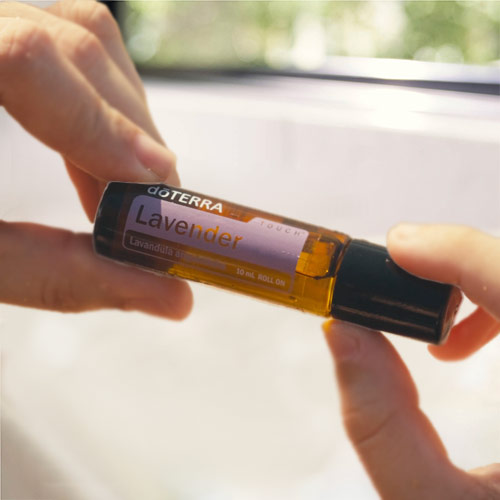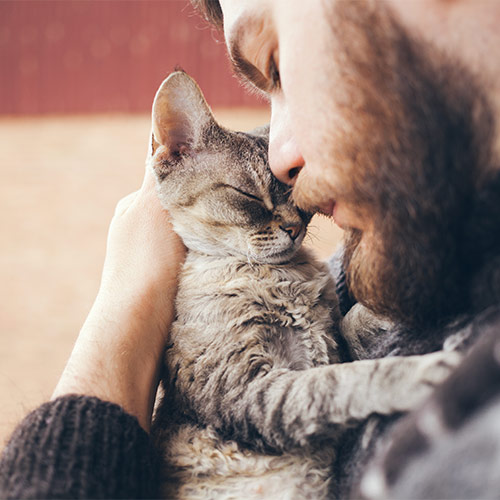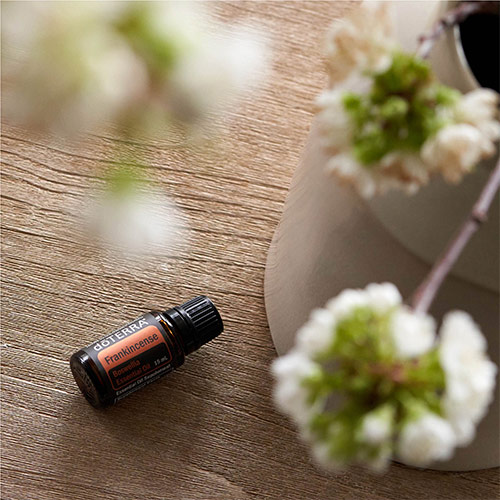Origin: a Latin derivative
meaning "Gift of the Earth."
Tips for Using Topical Essential Oils with Dogs and Cats
Did you know many of your favorite topical doTERRA essential oils can also be used safely on your family pets? With a little research and careful application, your furry friends can enjoy many topical and aromatic benefits.
However, not all essential oils are safe for cats and dogs, so you’ll need to follow important guidelines to keep your pets safe. Here are several tips to make your pet’s essential oil experience positive.
Tip 1: Know Which Essential Oils to Avoid
While essential oils offer numerous benefits, several aren’t safe for pets. Wintergreen, Birch, Tea Tree, Basil, citrus oils (like Bergamot, Grapefruit, Lemon, Lime, Orange, and Tangerine), Cinnamon Bark, Clove, Fennel, Oregano, Peppermint, Thyme, Rosemary, and Spearmint should all be avoided. Always look up an essential oil before using it on your furry friend and never use them on rodents, birds, reptiles, or amphibians.
Tip 2: Safely Introduce Essential Oils Aromatically
Diffusing is the safest way to expose pets to new essential oils or blends. Place one to two drops of the chosen essential oil in a water-based diffuser, placed in an open room. Ensure your pet is at least five feet away from the diffuser and free to leave the room. Observe their reactions closely, watching for signs of intolerance like avoidance or changes in breathing patterns. If your pet reacts well, you can apply the essential oil topically!


Tip 3: Dilute Essential Oils before Application
Because essential oils are potent plan essences, applying them “neat” (undiluted) is generally not recommended. Fractionated Coconut Oil is an excellent carrier oil to ensure safe application. doTERRA Touch® products are prediluted essential oils in roller bottles. While some should still be diluted further, others are already perfect for pets.
Recommended dilution ratios:
- Dogs: one to five drops of essential oil to 100 drops of carrier oil
- Cats: up to two drops of essential oil to 100 drops of carrier oil
Tip 4: Research the Properties of Essential Oils
Before using any essential oil on your pet, it’s important to understand its properties and potential effects. Some “hot” oils can burn the skin and must be more heavily diluted to be safe for your furry friends.
Tip 5: Remember Pets Can Ingest Essential Oils while Grooming
Pets, especially cats, groom themselves regularly. Any essential oil applied topically may be ingested during grooming. Always research whether an essential oil you plan to apply is safe to ingest before using it with your furry friends. Essential oils approved only for topical use should be used away from your pet’s mouth where they can be reached.
Tip 6: Learn Several Techniques for Topical Application
How you apply essential oils will be different for every pet. Some pets hate when you touch their paws or tummy. Others love vigorous belly scratches and are content to cuddle with you for hours on end. Here are several ways you can help your furry friends benefit from topical essential oils.


Direct Skin Application
Applying essential oils directly to pets’ skin is a great way to spot-treat skin irritations. You can also massage essential oils on their spine beneath their fur or on their stomach to promote a grounding or soothing environment.
- Lavender helps sooth irritated skin and is perfect for treating black fly or mosquito bites.
- Myrrh comforts the skin around cuts and scrapes.
- Frankincense calms minor skin irritations.
Never apply essential oils on large or infected wounds. Work with your veterinarian to ensure your pet receives proper treatment.
Petting Technique
Some animals prefer gentle pets to massages or spot treatment. Apply a diluted essential oil to clean hands and pet your furry friend either all over the body or on affected areas. (Pet hair sticks to moisture, so this step could get messy.) Not only will your animal benefit from the essential oils, but the physical touch can also strengthen the bond between you and your furry companion!
- AromaTouch® Massage Blend* can soothe a dog’s tired muscles and joints after a long hike.
- Lavender and Copaiba combined can do the same for your cat after a day of play.
- DigestZen® Digestive Blend* can provide soothing sensations on upset tummies.


Water Misting
If you want to apply essential oils over a larger area on your pet or simply don’t want to deal with sticky pet hair, you can use essential oil sprays. Dilute your chosen products in Fractionated Coconut Oil or water in a small glass spray bottle. Gently spray the diluted solution over your pet's fur, being careful to avoid the eyes, ears, and genitals. Always test the mixture on yourself to ensure it isn’t too strong and mind your pet’s movements while spritzing.
Here are a few ideas for DIY sprays to get you started:
Relaxing Spray
Trips to the vet, firework shows, and new people can sometimes make pets nervous. Help cultivate a comforting environment with this moisturizing spray.
- 20 drops Lavender
- 20 drops Frankincense
- 2 ounces water or Fractionated Coconut Oil
Skin-Soothing Spray
Outdoor playtime can come with all sorts of scrapes, cuts, or irritated skin—for you and your pet. This soothing skin spray is great for hard-playing pets and their loving humans.
- 20 drops Lavender
- 20 drops Frankincense
- 10 drops Myrrh
- 8 drops Geranium
- 8 drops Helichrysum
By implementing these tips and techniques, you can safely and effectively incorporate essential oils into pets’ wellness routines. Always remember to prioritize their well-being, dilute appropriately, and closely observe their reactions to ensure a positive and beneficial experience.

*Our veterinary advisory board has determined the essential oil ratios in these products to be generally safe for pets when used aromatically or topically.
Dr. Janis M. Fisher DVM, CVA, CCRT, CAC
Certified in veterinary acupuncture, canine rehabilitation, and animal chiropractics


